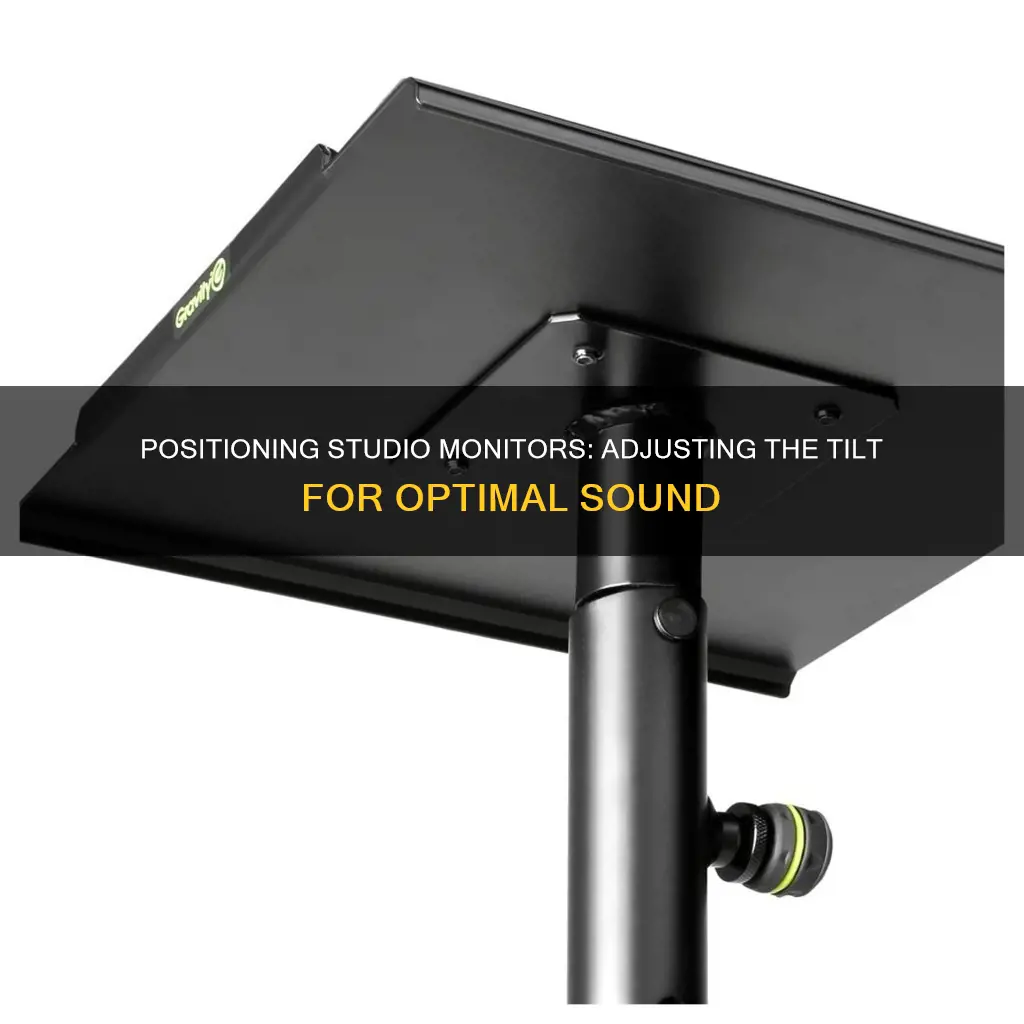
Studio monitor placement is crucial to achieving good sound quality. While the exact details are debated, most people agree that the ideal setup is to have your speakers form an equilateral triangle with your head, with the tweeters aimed directly at your ears. The height of your monitors should be either slightly above or below the mid-way point between the floor and ceiling. If you want to tilt your speakers, a downward tilt is preferable, but no more than 15 degrees.
| Characteristics | Values |
|---|---|
| Speaker position | Speakers should be placed after deciding where in the room you will be sitting. This is your mix position. |
| Studio monitor distance | Monitors should be about 2-3 feet from your work location and each other. |
| Studio monitor placement height | For free-standing equipment that is not tilted down, the ideal height is at least 47 inches from the floor with your tweeters aimed directly at your ears for the best listening quality. |
| Angle | Speakers should be angled at 15 degrees downwards but no more than that. The frequency changes if you tilt more than this. |
| Speaker setup | Speakers should make an equilateral triangle with your head and be at ear/head height. |
What You'll Learn
- Studio monitor placement: the ideal height for free-standing monitors is 47 inches from the floor
- Speaker position: the speakers should form an equilateral triangle with your head
- Studio monitor distance: the monitors should be 2-3 feet from your work location and each other
- Avoid placing monitors directly against the wall to prevent heavy bass response
- The optimum level to mix and work at is 83-85 dB to prevent ear fatigue

Studio monitor placement: the ideal height for free-standing monitors is 47 inches from the floor
Studio monitor placement is crucial to achieving the best sound quality. When it comes to the ideal height for free-standing monitors, the recommended height is at least 47 inches from the floor, ensuring that the tweeters are aimed directly at your ears for optimal listening. This placement ensures that your ears fall between the height of the centre of the woofer and the tweeter, resulting in a more accurate response from the speaker system.
To achieve this ideal height, you may need to use speaker stands or adjust the height of your desk or console. It is important to avoid placing your monitors directly against the wall, as it can lead to a heavy bass response. A distance of at least one to two feet from the walls and room boundaries is recommended. Additionally, the monitors should be positioned along the short wall of the room to minimise early reflections from nearby surfaces.
The angle of the monitors is also crucial. While some recommend having the monitors flat and directly aimed at your ears, others suggest a slight tilt. If you choose to tilt your monitors, a downward tilt of about 15 degrees is suggested, as tilting them more can cause frequency changes. However, it is important to note that moving in and out of the on-axis position with the tweeters can affect the frequency response. Therefore, it is generally recommended to keep the monitors flat and only tilt them if necessary to minimise reflections.
The placement of the monitors in relation to your listening position is also essential. The ideal setup is to create an equilateral triangle with your monitors and your head, ensuring that your head is slightly closer to the speakers than the tip of the triangle. This setup helps achieve the best stereo imaging and consistent sound. Additionally, the monitors should be positioned symmetrically on a single wall, especially in rectangular rooms, to minimise imbalances in sound between the left and right speakers.
Finding Nits: Monitor Inspection Techniques for Beginners
You may want to see also

Speaker position: the speakers should form an equilateral triangle with your head
When setting up studio monitors, it is important to pay attention to their position in relation to your head. The ideal setup is to have your speakers form an equilateral triangle with your head, with your two speakers as the base of the triangle and your head at the apex. This means that the distance from each speaker to your head should be the same as the distance between the speakers.
However, this does not mean that the speakers should be aimed directly at your head. Instead, they should be angled slightly outwards so that their acoustic axes intersect at a point several inches behind your head. This is because the flattest speaker response is "on-axis", and angling the speakers ensures that your ears, not your eyes, are on this axis. This setup will give you the best stereo imaging, clearest soundstage, and broadest sweet spot.
The distance between your speakers and your head will depend on the size of your room. In a small home studio, a typical distance from each speaker to your head might be around 49-50 inches. However, the specific measurements are less important than ensuring that the speakers are angled correctly towards your ears.
It is also important to consider the height of your speakers. The ideal height is for the tweeters to be aimed directly at your ears. If you are using free-standing monitors that are not tilted, the recommended height is at least 47 inches from the floor. If you want to tilt your speakers, a 15-degree tilt is recommended, but no more than this as it can affect the frequency response.
In addition to speaker position and height, you should also consider the distance of your speakers from the walls. Avoid placing them directly against the wall, as this can cause a heavy bass response. Aim for a distance of at least one to two feet away from the walls and room boundaries.
Is My iPhone Being Monitored? Here's How to Find Out
You may want to see also

Studio monitor distance: the monitors should be 2-3 feet from your work location and each other
Studio monitor placement is crucial to achieving good sound quality. Even the most expensive, high-quality equipment will not deliver the desired results if the monitors are not positioned correctly.
The ideal studio setup is to have your speakers form an equilateral triangle, with your two speakers as the base and your work position at the head. This setup ensures a consistent listening perspective and stereo image width across different studios.
To achieve optimal sound quality, studio monitors should be placed 2-3 feet from your work location and each other. While this distance is ideal, it doesn't have to be exact, but the closer you can get, the better the sound quality will be. Dedicated speaker stands can help accomplish this distance ratio. It is also important to avoid placing your monitors directly against the wall, as this can cause a heavy bass response. Aim for at least a foot or two of distance between the monitors and the walls.
In addition to the distance from your work location, the height of your studio monitors is also crucial. For free-standing monitors that are not tilted down, the ideal height is at least 47 inches from the floor, with the tweeters aimed directly at your ears. If you want to tilt your monitors down, a 15-degree tilt is recommended, as tilting more can cause changes in frequency response. For flush-mounted main studio monitors, a height of about 56 inches is recommended to ensure optimal sound quality whether you are sitting or standing.
By following these guidelines for studio monitor placement, you will be able to create a balanced and consistent listening environment, ensuring that your mixes sound great not only in your studio but also anywhere else.
Monitoring Internet Usage: A Guide for Modem Users
You may want to see also

Avoid placing monitors directly against the wall to prevent heavy bass response
When setting up studio monitors, it is important to consider the distance between the monitors and the wall behind them. Placing monitors too close to the wall can result in a buildup of bass frequencies, leading to an uneven bass response and a less accurate sound. This phenomenon is known as speaker-boundary interference (SBIR) and can cause low-frequency cancellations and a "one-note bass" sound.
To avoid this issue, it is recommended to keep studio monitors at least a foot or two away from the wall. This distance can vary depending on the size and design of the room, but a minimum of 6 to 10 inches is generally advised. Ideally, the distance should be greater, with 2 to 3 feet being preferable. By increasing the distance between the monitors and the wall, you can minimize bass buildup and achieve a more accurate sound.
In addition to the distance from the wall, other factors such as the placement of the monitors in relation to the listening position, the height of the monitors, and the use of isolation pads or stands can also impact the sound quality. It is important to consider all these factors when setting up studio monitors to ensure optimal sound performance.
Furthermore, the placement of the monitors in relation to the listening position is crucial. Ideally, the monitors should form an equilateral triangle with the listener's head, with the distance between the left and right speakers and the distance from each speaker to the back of the head being equal. This setup helps to create a natural stereo "sweet spot" and improves the overall sound imaging.
In summary, to prevent heavy bass response and achieve optimal sound performance, it is essential to avoid placing studio monitors directly against the wall and to consider the distance from the wall, placement in relation to the listening position, and other factors such as height and isolation. By following these guidelines, you can ensure that your studio monitors deliver the most accurate and high-quality sound possible.
Understanding Handle Count: Performance Monitor's Essential Metric
You may want to see also

The optimum level to mix and work at is 83-85 dB to prevent ear fatigue
Studio monitors should be placed in the optimal listening position, which is usually where the tweeters are aimed directly at your ears. This is typically at ear height, around 47 inches from the floor for free-standing monitors, and 56 inches for flush-mounted monitors. If you want to tilt your monitors, a 15-degree tilt is recommended, but no more than that as it can affect the frequency response.
When it comes to mixing and working with studio monitors, it is essential to maintain a healthy volume level to prevent ear fatigue and long-term hearing damage. The optimum level is between 83 and 85 dB, according to experts. Exposing your ears to louder volumes for extended periods can lead to hearing fatigue and, eventually, hearing loss. At 85 dB, the maximum recommended duration is eight hours per day. However, this may vary depending on the size and acoustics of your room.
To ensure you are mixing at a safe and optimal level, it is advisable to use a sound pressure level (SPL) meter to measure the volume accurately. Additionally, it is crucial to take regular breaks, as extended periods of listening at high volumes can cause ear fatigue. A good rule of thumb is to take a 10-minute break every hour or a 20-minute break every 90 minutes. This will help you maintain fresh ears and make better mixing decisions.
It is also beneficial to vary the volume levels while mixing. Starting at a lower volume and gradually increasing it can help identify problem areas in your mix and prevent ear fatigue. This technique can also improve your mix's translation to other sound systems. However, it is important to note that mixing at extremely low volumes may not accurately represent the bass and high-end frequencies in your final mix.
In conclusion, finding the right balance between volume, monitor placement, and taking regular breaks is crucial for maintaining optimal hearing health and achieving the best results in your mixes. By following these guidelines, you can protect your ears and create high-quality mixes that translate well across different playback systems.
Hooking Arcade Monitors: Power Supply Connection Point?
You may want to see also
Frequently asked questions
The ideal height depends on whether you are using free-standing studio monitors or mounted, flush units. For free-standing equipment that is not tilted down, the ideal height is at least 47 inches from the floor with your tweeters aimed directly at your ears for the best listening quality. For main studio monitors that are flush-mounted, the recommended height is about 56 inches off the ground to ensure the best sound quality whether sitting or standing.
If you want to tilt your speakers down, go for about a 15-degree tilt but no more than that. The frequency changes if you tilt more than this.
The standard mixing position is to have your head form an equilateral triangle with your monitors. Point the monitors directly towards your head.
Ensure that the height of your monitors is either slightly above or below the mid-way point between the floor and ceiling. Vary the distances between your monitors and the walls. Create space between the monitors and the rear wall to reduce the strength of the reflections.







